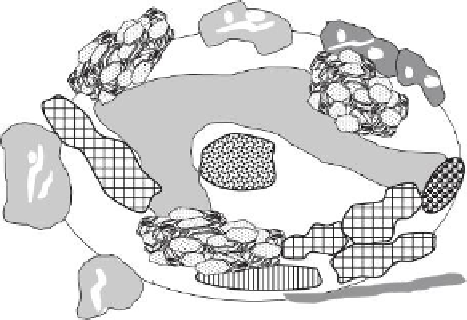Environmental Engineering Reference
In-Depth Information
Bacterial
cells
Hydrated DARAMEND
particles colonized by
native soil bacteria
Clay/organic matter
agglomerate
Mineral
particle
Hydrocarbons
desorb from soil
and diffuse to
DARAMEND
where
biodegradation
occurs
Clay
platelets
Fungal mycella
Water film
Organic matter sequioxides
FIGURE 11.11
Schematic of the DARAMEND technology. (Adapted from Mulligan, C.N.,
Environmental Biotreatment,
Government Institutes, Rockville, MD, 2002.)
In Asia, a land-farming process was performed on hydrocarbon-contaminated soil
(Figure 11.10). The TPH content of 3700 mg/kg was reduced to less than 450 mg/kg.
The BTEX was reduced from greater than 80 mg/kg to undetectable levels in 90 days.
Commercial microbes and nutrients were added, and the soil was tilled three times a
week. The soil moisture was maintained at 40% to 60% soil capacity. Weekly monitoring
for TPH, BTEX, nitrates, phosphorus, ammonia, aerobic respiration, pH, microbial counts,
and moisture contents were conducted. Volumes of greater than 4000 m
3
were treated in
each batch.
11.5.3 Composting
Composting involves the biodegradation of organic materials to produce carbon dioxide
and water for soils and sediments. Typical temperatures are in the range of 55°C to 65°C
due to the heat from the biodegradation process. Animal or vegetable wastes such as sew-
age sludge are often used as organic amendments. Bulking agents to increase the porosity
of the material such as woods chips are added. Moisture content and temperature must be
monitored. Composting processes include windrows and biopiles, and in vessel compost-
ing. Gaseous emissions and leachates may be produced and thus will need to be managed.
Thermophilic composting can be applied to the treatment of explosive or PAH contami-
nated soils. Composting costs can range from $320 to $460/m
3
.
The contaminated sediment composting study evaluated by Khan and Anjaneyulu
(2006) consisted of a mixture of 10 kg of sediment with 0.5% fertilizer and 50% compost.
The sediment contaminants included phenols (16-24 mg/kg) and benzene (3.4 mg/kg).












Search WWH ::

Custom Search